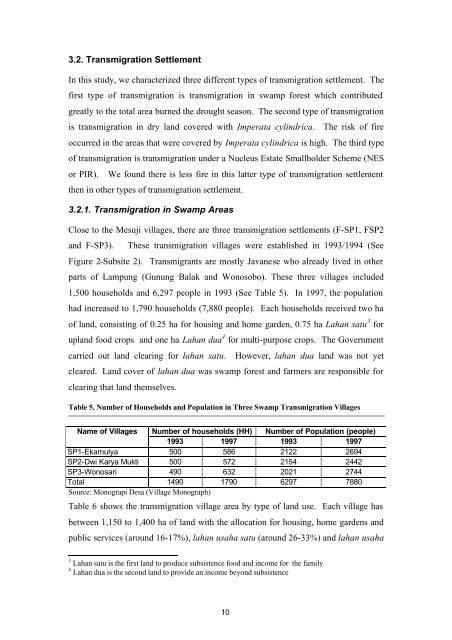English - Center for International Forestry Research
English - Center for International Forestry Research
English - Center for International Forestry Research
You also want an ePaper? Increase the reach of your titles
YUMPU automatically turns print PDFs into web optimized ePapers that Google loves.
3.2. Transmigration Settlement<br />
In this study, we characterized three different types of transmigration settlement. The<br />
first type of transmigration is transmigration in swamp <strong>for</strong>est which contributed<br />
greatly to the total area burned the drought season. The second type of transmigration<br />
is transmigration in dry land covered with Imperata cylindrica. The risk of fire<br />
occurred in the areas that were covered by Imperata cylindrica is high. The third type<br />
of transmigration is transmigration under a Nucleus Estate Smallholder Scheme (NES<br />
or PIR). We found there is less fire in this latter type of transmigration settlement<br />
then in other types of transmigration settlement.<br />
3.2.1. Transmigration in Swamp Areas<br />
Close to the Mesuji villages, there are three transmigration settlements (F-SP1, FSP2<br />
and F-SP3). These transmigration villages were established in 1993/1994 (See<br />
Figure 2-Subsite 2). Transmigrants are mostly Javanese who already lived in other<br />
parts of Lampung (Gunung Balak and Wonosobo). These three villages included<br />
1,500 households and 6,297 people in 1993 (See Table 5). In 1997, the population<br />
had increased to 1,790 households (7,880 people). Each households received two ha<br />
of land, consisting of 0.25 ha <strong>for</strong> housing and home garden, 0.75 ha Lahan satu 3 <strong>for</strong><br />
upland food crops and one ha Lahan dua 4 <strong>for</strong> multi-purpose crops. The Government<br />
carried out land clearing <strong>for</strong> lahan satu. However, lahan dua land was not yet<br />
cleared. Land cover of lahan dua was swamp <strong>for</strong>est and farmers are responsible <strong>for</strong><br />
clearing that land themselves.<br />
Table 5. Number of Households and Population in Three Swamp Transmigration Villages<br />
Name of Villages Number of households (HH) Number of Population (people)<br />
1993 1997 1993 1997<br />
SP1-Ekamulya 500 586 2122 2694<br />
SP2-Dwi Karya Mukti 500 572 2154 2442<br />
SP3-Wonosari 490 632 2021 2744<br />
Total 1490 1790 6297 7880<br />
Source: Monograpi Desa (Village Monograph)<br />
Table 6 shows the transmigration village area by type of land use. Each village has<br />
between 1,150 to 1,400 ha of land with the allocation <strong>for</strong> housing, home gardens and<br />
public services (around 16-17%), lahan usaha satu (around 26-33%) and lahan usaha<br />
3 Lahan satu is the first land to produce subsistence food and income <strong>for</strong> the family<br />
4 Lahan dua is the second land to provide an income beyond subsistence<br />
10
















